Financial Accounting: Income, Revenue, Gains, Cash Flow & Airbus Order
VerifiedAdded on 2023/06/18
|9
|1636
|95
Case Study
AI Summary
This case study delves into key aspects of financial accounting, starting with a clarification of the differences between income, revenue, and gains. It addresses the accounting treatment of an Airbus A380 order, considering the conceptual framework's definitions of assets and liabilities, and examines the implications of price fluctuations. The study also provides a practical example of share issuance with oversubscription, demonstrating the relevant journal entries. Furthermore, it analyzes the effects of various transactions on the statement of cash flows, categorizing them as operating, investing, or financing activities. Finally, the case study includes a conversion from accrual-basis items to cash basis, calculating cash collected from customers and cash paid to suppliers and employees, highlighting the importance of accurate financial reporting for strategic decision-making. Desklib offers solved assignments and past papers for students.
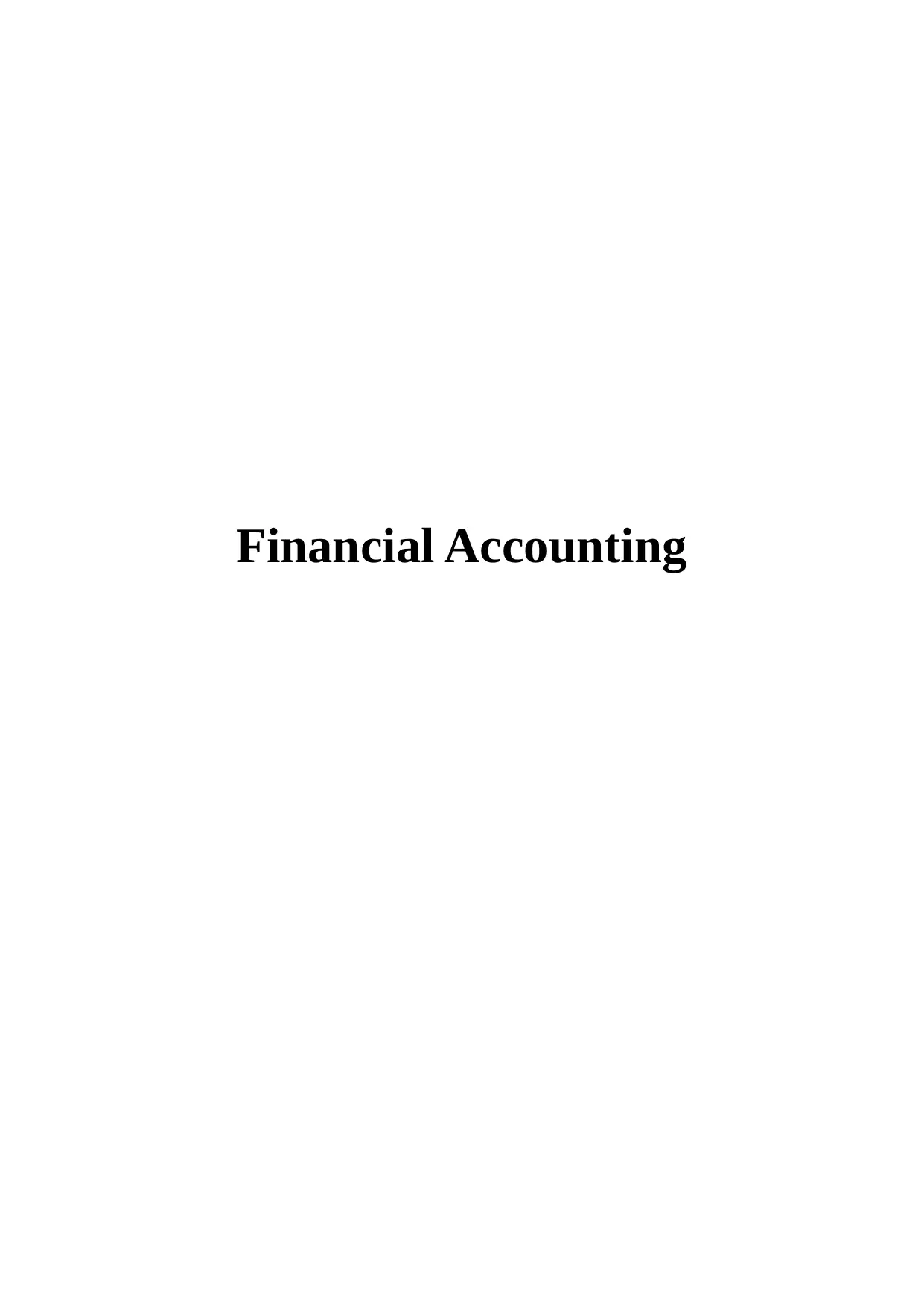
Financial Accounting
Paraphrase This Document
Need a fresh take? Get an instant paraphrase of this document with our AI Paraphraser
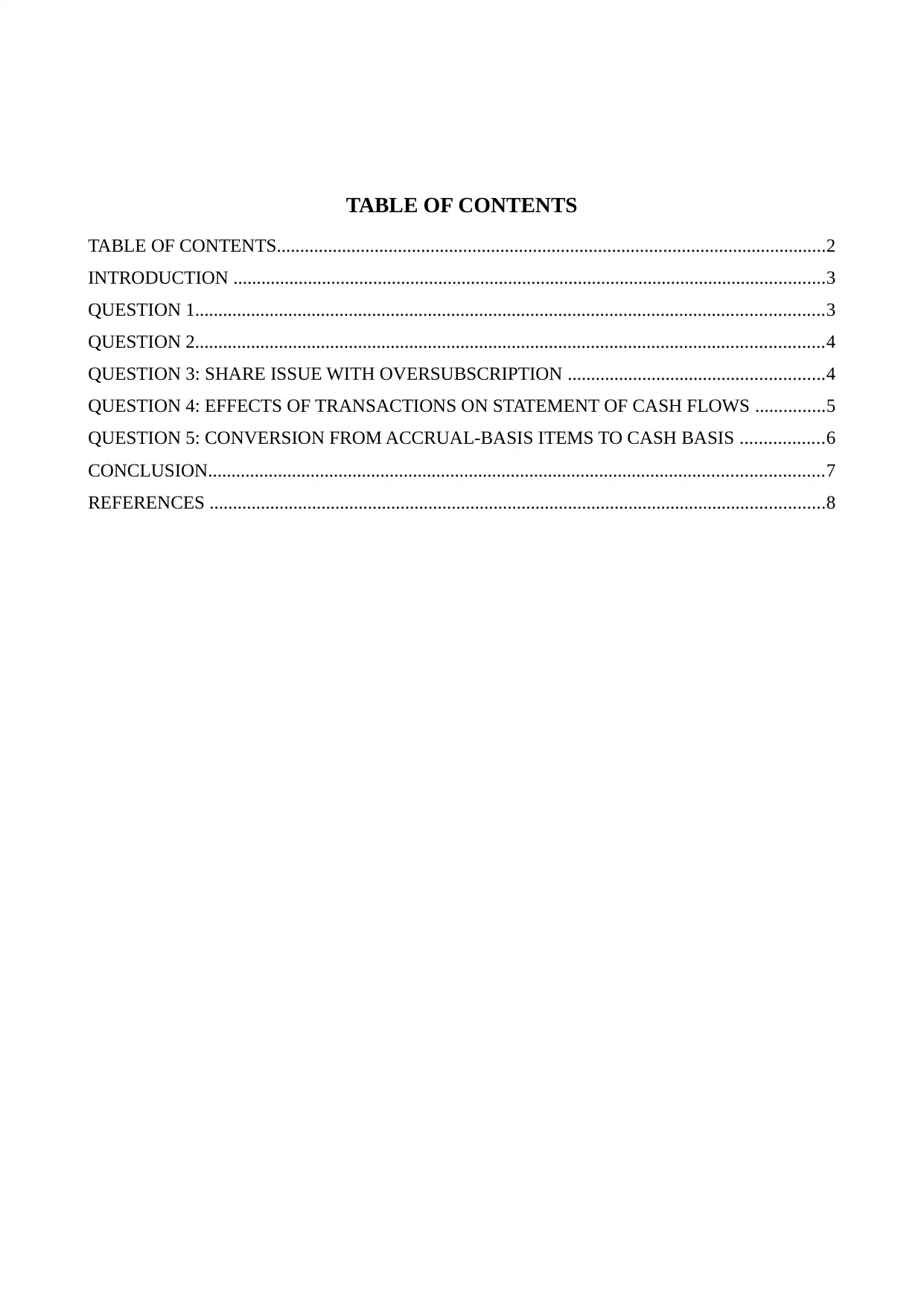
TABLE OF CONTENTS
TABLE OF CONTENTS......................................................................................................................2
INTRODUCTION ...............................................................................................................................3
QUESTION 1.......................................................................................................................................3
QUESTION 2.......................................................................................................................................4
QUESTION 3: SHARE ISSUE WITH OVERSUBSCRIPTION .......................................................4
QUESTION 4: EFFECTS OF TRANSACTIONS ON STATEMENT OF CASH FLOWS ...............5
QUESTION 5: CONVERSION FROM ACCRUAL-BASIS ITEMS TO CASH BASIS ..................6
CONCLUSION....................................................................................................................................7
REFERENCES ....................................................................................................................................8
TABLE OF CONTENTS......................................................................................................................2
INTRODUCTION ...............................................................................................................................3
QUESTION 1.......................................................................................................................................3
QUESTION 2.......................................................................................................................................4
QUESTION 3: SHARE ISSUE WITH OVERSUBSCRIPTION .......................................................4
QUESTION 4: EFFECTS OF TRANSACTIONS ON STATEMENT OF CASH FLOWS ...............5
QUESTION 5: CONVERSION FROM ACCRUAL-BASIS ITEMS TO CASH BASIS ..................6
CONCLUSION....................................................................................................................................7
REFERENCES ....................................................................................................................................8
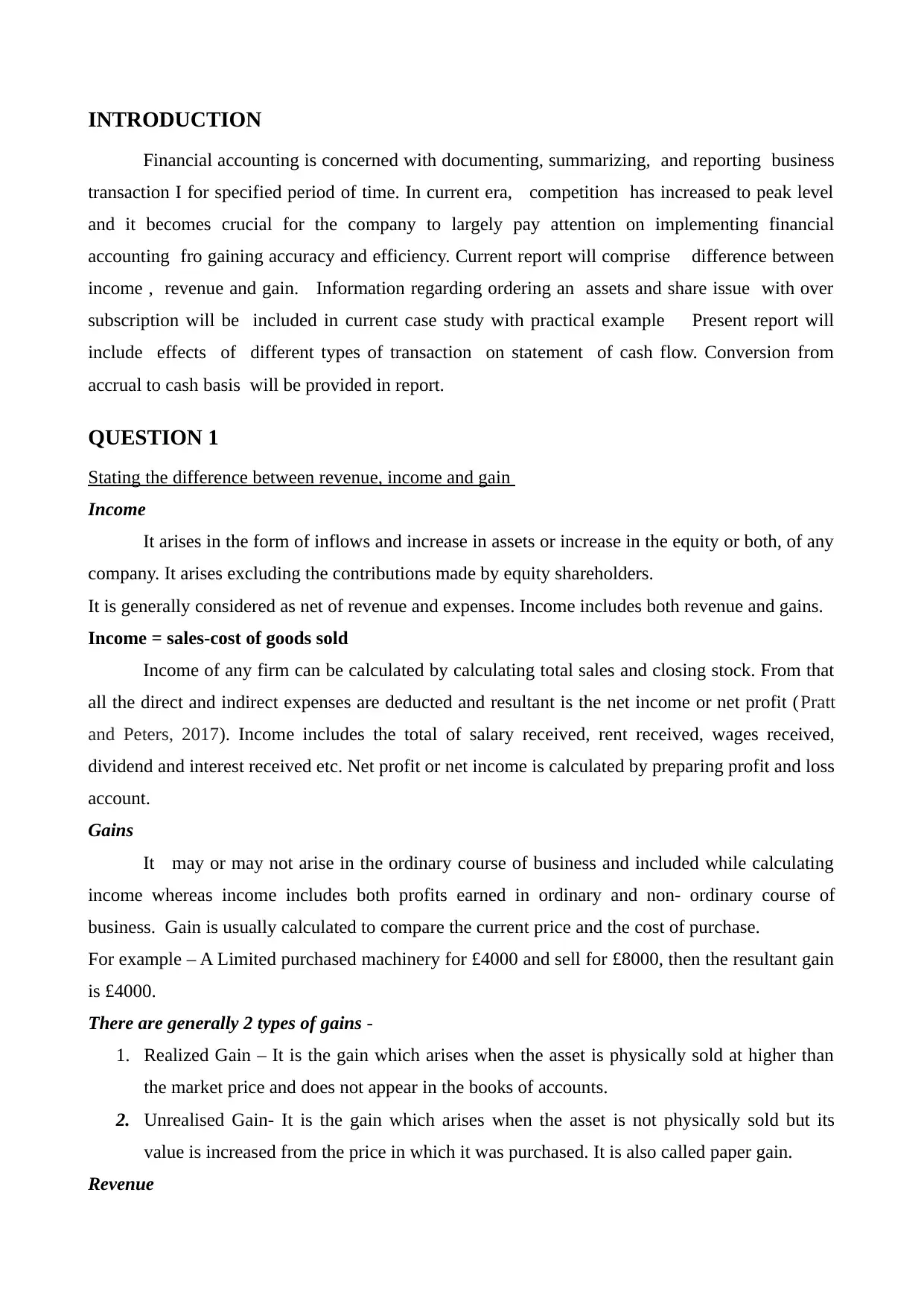
INTRODUCTION
Financial accounting is concerned with documenting, summarizing, and reporting business
transaction I for specified period of time. In current era, competition has increased to peak level
and it becomes crucial for the company to largely pay attention on implementing financial
accounting fro gaining accuracy and efficiency. Current report will comprise difference between
income , revenue and gain. Information regarding ordering an assets and share issue with over
subscription will be included in current case study with practical example Present report will
include effects of different types of transaction on statement of cash flow. Conversion from
accrual to cash basis will be provided in report.
QUESTION 1
Stating the difference between revenue, income and gain
Income
It arises in the form of inflows and increase in assets or increase in the equity or both, of any
company. It arises excluding the contributions made by equity shareholders.
It is generally considered as net of revenue and expenses. Income includes both revenue and gains.
Income = sales-cost of goods sold
Income of any firm can be calculated by calculating total sales and closing stock. From that
all the direct and indirect expenses are deducted and resultant is the net income or net profit (Pratt
and Peters, 2017). Income includes the total of salary received, rent received, wages received,
dividend and interest received etc. Net profit or net income is calculated by preparing profit and loss
account.
Gains
It may or may not arise in the ordinary course of business and included while calculating
income whereas income includes both profits earned in ordinary and non- ordinary course of
business. Gain is usually calculated to compare the current price and the cost of purchase.
For example – A Limited purchased machinery for £4000 and sell for £8000, then the resultant gain
is £4000.
There are generally 2 types of gains -
1. Realized Gain – It is the gain which arises when the asset is physically sold at higher than
the market price and does not appear in the books of accounts.
2. Unrealised Gain- It is the gain which arises when the asset is not physically sold but its
value is increased from the price in which it was purchased. It is also called paper gain.
Revenue
Financial accounting is concerned with documenting, summarizing, and reporting business
transaction I for specified period of time. In current era, competition has increased to peak level
and it becomes crucial for the company to largely pay attention on implementing financial
accounting fro gaining accuracy and efficiency. Current report will comprise difference between
income , revenue and gain. Information regarding ordering an assets and share issue with over
subscription will be included in current case study with practical example Present report will
include effects of different types of transaction on statement of cash flow. Conversion from
accrual to cash basis will be provided in report.
QUESTION 1
Stating the difference between revenue, income and gain
Income
It arises in the form of inflows and increase in assets or increase in the equity or both, of any
company. It arises excluding the contributions made by equity shareholders.
It is generally considered as net of revenue and expenses. Income includes both revenue and gains.
Income = sales-cost of goods sold
Income of any firm can be calculated by calculating total sales and closing stock. From that
all the direct and indirect expenses are deducted and resultant is the net income or net profit (Pratt
and Peters, 2017). Income includes the total of salary received, rent received, wages received,
dividend and interest received etc. Net profit or net income is calculated by preparing profit and loss
account.
Gains
It may or may not arise in the ordinary course of business and included while calculating
income whereas income includes both profits earned in ordinary and non- ordinary course of
business. Gain is usually calculated to compare the current price and the cost of purchase.
For example – A Limited purchased machinery for £4000 and sell for £8000, then the resultant gain
is £4000.
There are generally 2 types of gains -
1. Realized Gain – It is the gain which arises when the asset is physically sold at higher than
the market price and does not appear in the books of accounts.
2. Unrealised Gain- It is the gain which arises when the asset is not physically sold but its
value is increased from the price in which it was purchased. It is also called paper gain.
Revenue
⊘ This is a preview!⊘
Do you want full access?
Subscribe today to unlock all pages.

Trusted by 1+ million students worldwide
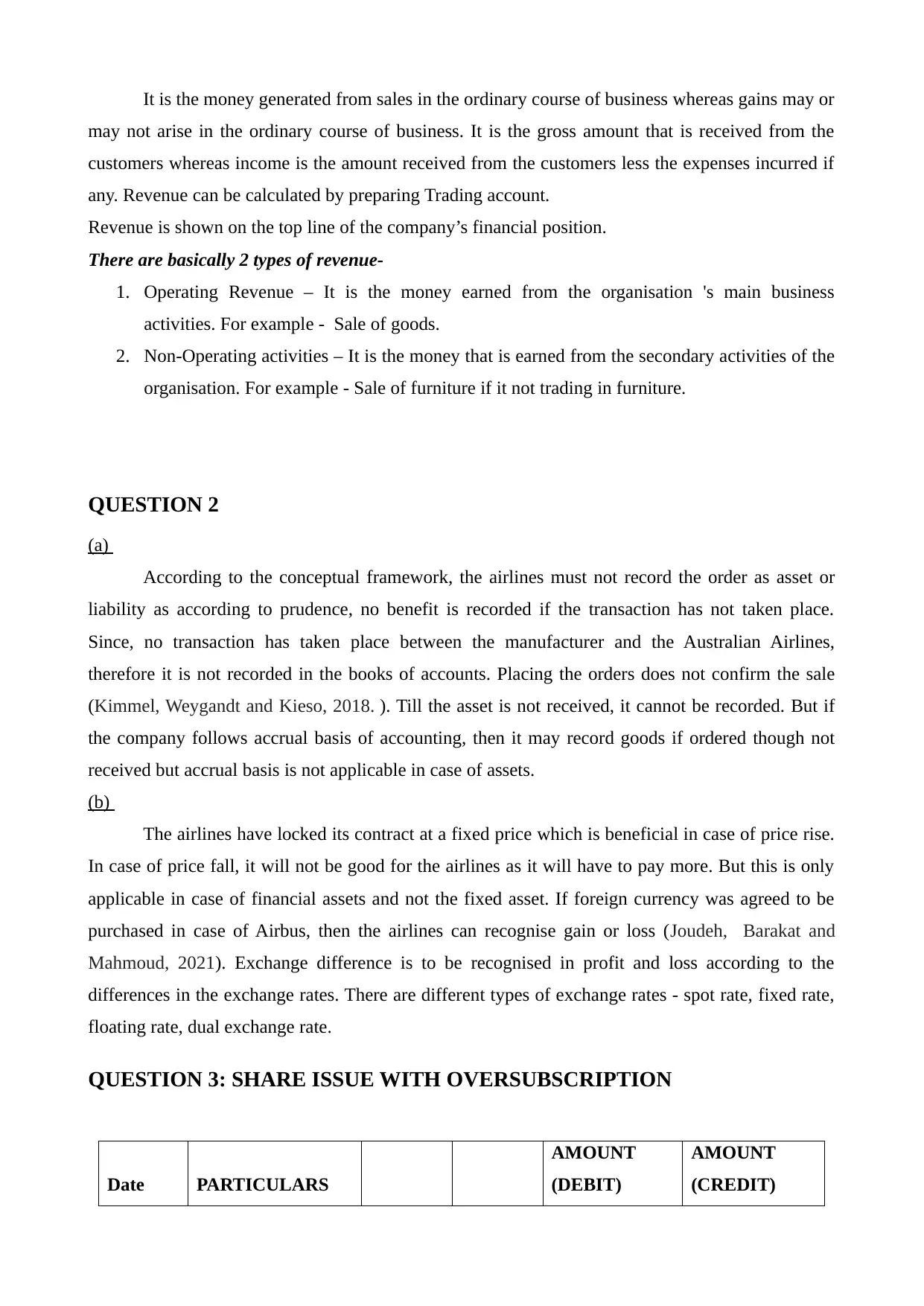
It is the money generated from sales in the ordinary course of business whereas gains may or
may not arise in the ordinary course of business. It is the gross amount that is received from the
customers whereas income is the amount received from the customers less the expenses incurred if
any. Revenue can be calculated by preparing Trading account.
Revenue is shown on the top line of the company’s financial position.
There are basically 2 types of revenue-
1. Operating Revenue – It is the money earned from the organisation 's main business
activities. For example - Sale of goods.
2. Non-Operating activities – It is the money that is earned from the secondary activities of the
organisation. For example - Sale of furniture if it not trading in furniture.
QUESTION 2
(a)
According to the conceptual framework, the airlines must not record the order as asset or
liability as according to prudence, no benefit is recorded if the transaction has not taken place.
Since, no transaction has taken place between the manufacturer and the Australian Airlines,
therefore it is not recorded in the books of accounts. Placing the orders does not confirm the sale
(Kimmel, Weygandt and Kieso, 2018. ). Till the asset is not received, it cannot be recorded. But if
the company follows accrual basis of accounting, then it may record goods if ordered though not
received but accrual basis is not applicable in case of assets.
(b)
The airlines have locked its contract at a fixed price which is beneficial in case of price rise.
In case of price fall, it will not be good for the airlines as it will have to pay more. But this is only
applicable in case of financial assets and not the fixed asset. If foreign currency was agreed to be
purchased in case of Airbus, then the airlines can recognise gain or loss (Joudeh, Barakat and
Mahmoud, 2021). Exchange difference is to be recognised in profit and loss according to the
differences in the exchange rates. There are different types of exchange rates - spot rate, fixed rate,
floating rate, dual exchange rate.
QUESTION 3: SHARE ISSUE WITH OVERSUBSCRIPTION
Date PARTICULARS
AMOUNT
(DEBIT)
AMOUNT
(CREDIT)
may not arise in the ordinary course of business. It is the gross amount that is received from the
customers whereas income is the amount received from the customers less the expenses incurred if
any. Revenue can be calculated by preparing Trading account.
Revenue is shown on the top line of the company’s financial position.
There are basically 2 types of revenue-
1. Operating Revenue – It is the money earned from the organisation 's main business
activities. For example - Sale of goods.
2. Non-Operating activities – It is the money that is earned from the secondary activities of the
organisation. For example - Sale of furniture if it not trading in furniture.
QUESTION 2
(a)
According to the conceptual framework, the airlines must not record the order as asset or
liability as according to prudence, no benefit is recorded if the transaction has not taken place.
Since, no transaction has taken place between the manufacturer and the Australian Airlines,
therefore it is not recorded in the books of accounts. Placing the orders does not confirm the sale
(Kimmel, Weygandt and Kieso, 2018. ). Till the asset is not received, it cannot be recorded. But if
the company follows accrual basis of accounting, then it may record goods if ordered though not
received but accrual basis is not applicable in case of assets.
(b)
The airlines have locked its contract at a fixed price which is beneficial in case of price rise.
In case of price fall, it will not be good for the airlines as it will have to pay more. But this is only
applicable in case of financial assets and not the fixed asset. If foreign currency was agreed to be
purchased in case of Airbus, then the airlines can recognise gain or loss (Joudeh, Barakat and
Mahmoud, 2021). Exchange difference is to be recognised in profit and loss according to the
differences in the exchange rates. There are different types of exchange rates - spot rate, fixed rate,
floating rate, dual exchange rate.
QUESTION 3: SHARE ISSUE WITH OVERSUBSCRIPTION
Date PARTICULARS
AMOUNT
(DEBIT)
AMOUNT
(CREDIT)
Paraphrase This Document
Need a fresh take? Get an instant paraphrase of this document with our AI Paraphraser
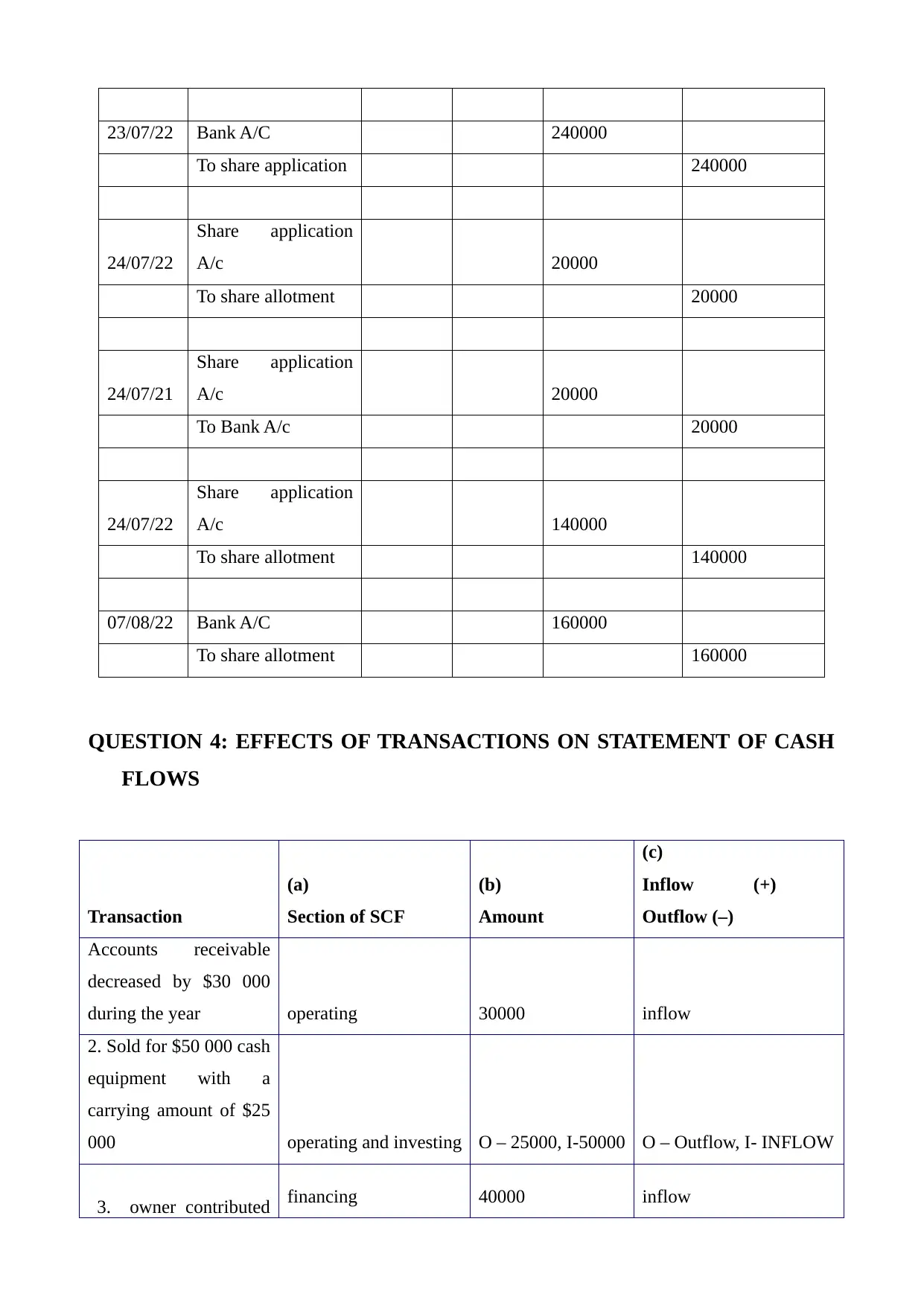
23/07/22 Bank A/C 240000
To share application 240000
24/07/22
Share application
A/c 20000
To share allotment 20000
24/07/21
Share application
A/c 20000
To Bank A/c 20000
24/07/22
Share application
A/c 140000
To share allotment 140000
07/08/22 Bank A/C 160000
To share allotment 160000
QUESTION 4: EFFECTS OF TRANSACTIONS ON STATEMENT OF CASH
FLOWS
Transaction
(a)
Section of SCF
(b)
Amount
(c)
Inflow (+)
Outflow (–)
Accounts receivable
decreased by $30 000
during the year operating 30000 inflow
2. Sold for $50 000 cash
equipment with a
carrying amount of $25
000 operating and investing O – 25000, I-50000 O – Outflow, I- INFLOW
3. owner contributed financing 40000 inflow
To share application 240000
24/07/22
Share application
A/c 20000
To share allotment 20000
24/07/21
Share application
A/c 20000
To Bank A/c 20000
24/07/22
Share application
A/c 140000
To share allotment 140000
07/08/22 Bank A/C 160000
To share allotment 160000
QUESTION 4: EFFECTS OF TRANSACTIONS ON STATEMENT OF CASH
FLOWS
Transaction
(a)
Section of SCF
(b)
Amount
(c)
Inflow (+)
Outflow (–)
Accounts receivable
decreased by $30 000
during the year operating 30000 inflow
2. Sold for $50 000 cash
equipment with a
carrying amount of $25
000 operating and investing O – 25000, I-50000 O – Outflow, I- INFLOW
3. owner contributed financing 40000 inflow
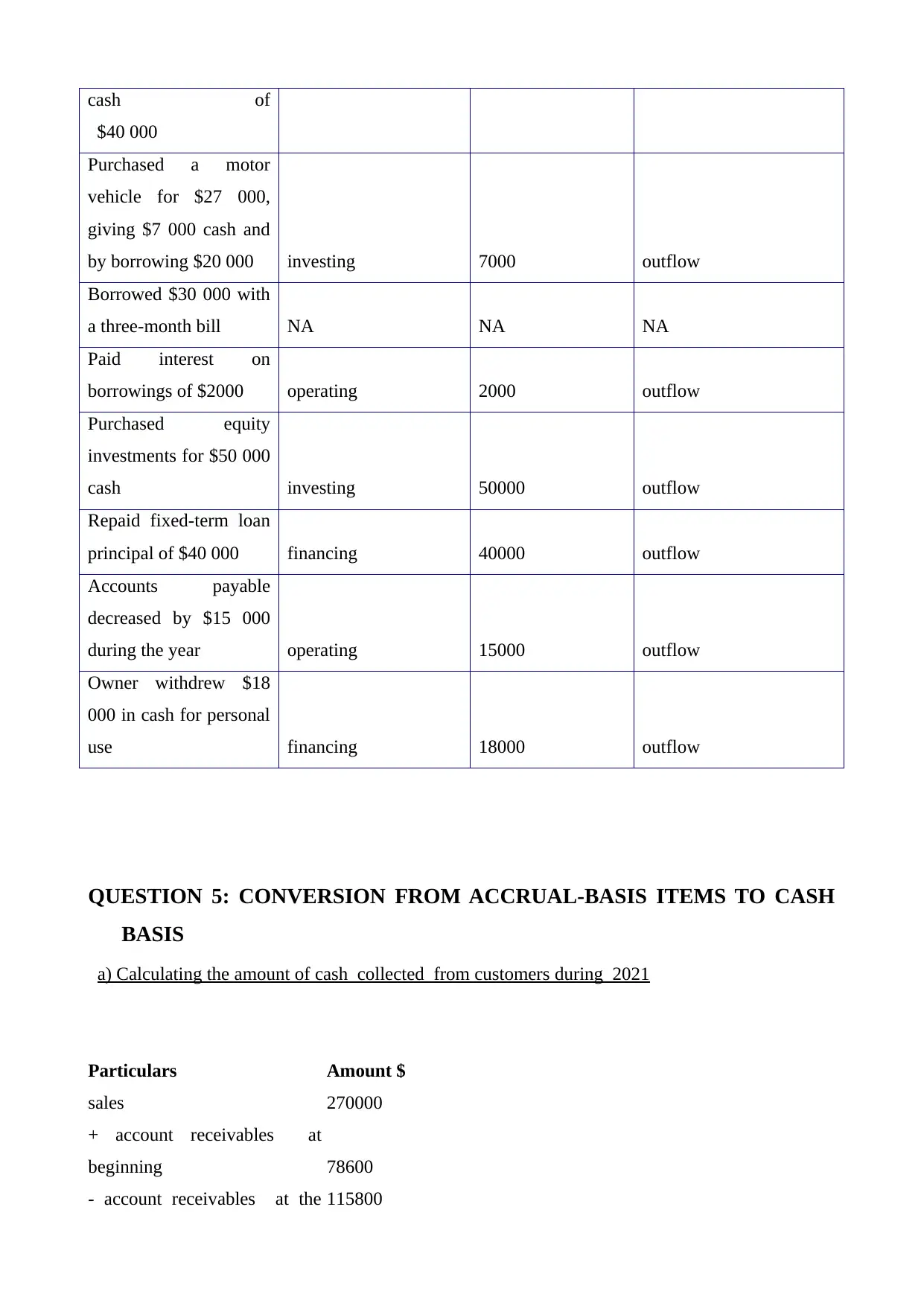
cash of
$40 000
Purchased a motor
vehicle for $27 000,
giving $7 000 cash and
by borrowing $20 000 investing 7000 outflow
Borrowed $30 000 with
a three-month bill NA NA NA
Paid interest on
borrowings of $2000 operating 2000 outflow
Purchased equity
investments for $50 000
cash investing 50000 outflow
Repaid fixed-term loan
principal of $40 000 financing 40000 outflow
Accounts payable
decreased by $15 000
during the year operating 15000 outflow
Owner withdrew $18
000 in cash for personal
use financing 18000 outflow
QUESTION 5: CONVERSION FROM ACCRUAL-BASIS ITEMS TO CASH
BASIS
a) Calculating the amount of cash collected from customers during 2021
Particulars Amount $
sales 270000
+ account receivables at
beginning 78600
- account receivables at the 115800
$40 000
Purchased a motor
vehicle for $27 000,
giving $7 000 cash and
by borrowing $20 000 investing 7000 outflow
Borrowed $30 000 with
a three-month bill NA NA NA
Paid interest on
borrowings of $2000 operating 2000 outflow
Purchased equity
investments for $50 000
cash investing 50000 outflow
Repaid fixed-term loan
principal of $40 000 financing 40000 outflow
Accounts payable
decreased by $15 000
during the year operating 15000 outflow
Owner withdrew $18
000 in cash for personal
use financing 18000 outflow
QUESTION 5: CONVERSION FROM ACCRUAL-BASIS ITEMS TO CASH
BASIS
a) Calculating the amount of cash collected from customers during 2021
Particulars Amount $
sales 270000
+ account receivables at
beginning 78600
- account receivables at the 115800
⊘ This is a preview!⊘
Do you want full access?
Subscribe today to unlock all pages.

Trusted by 1+ million students worldwide
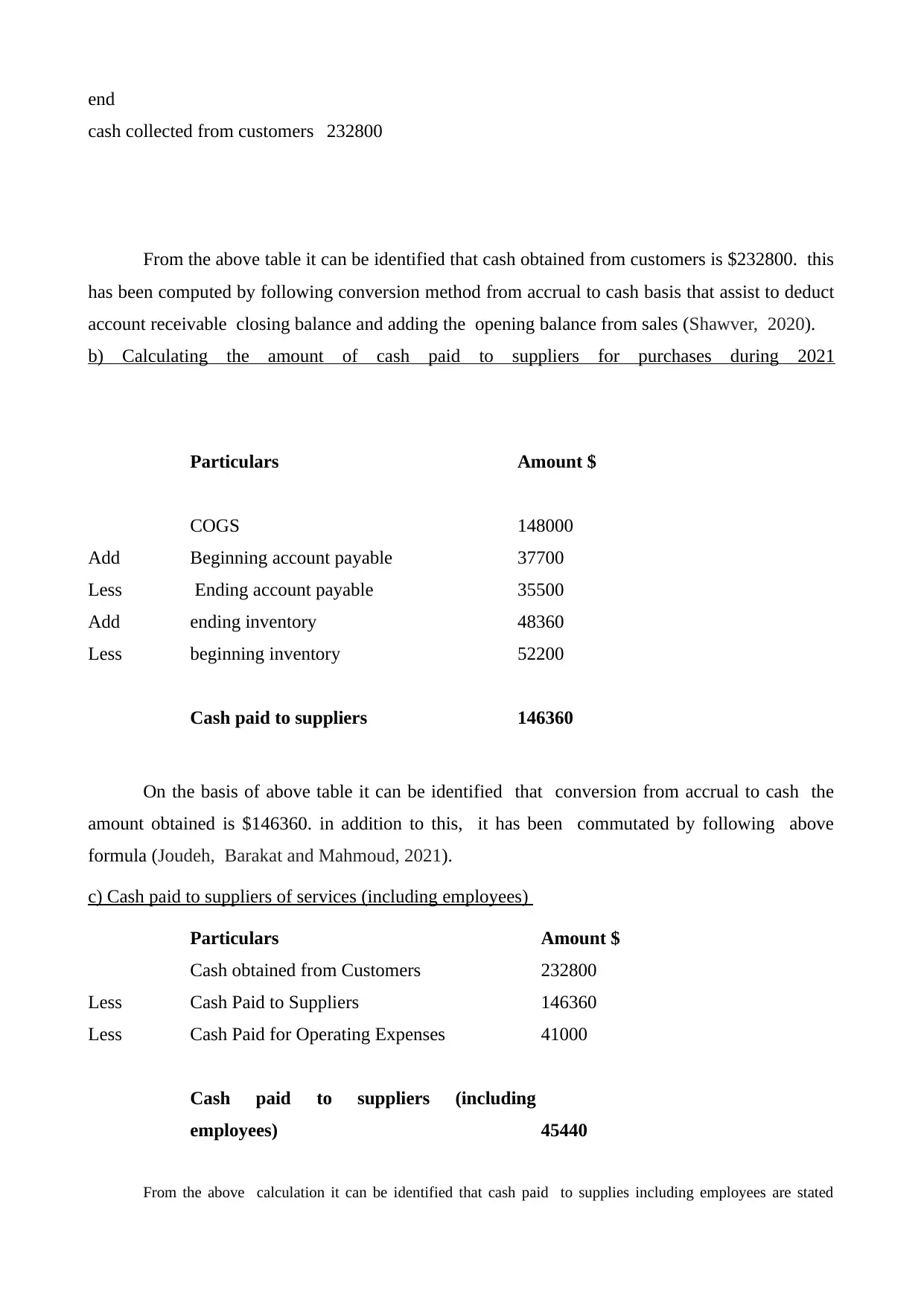
end
cash collected from customers 232800
From the above table it can be identified that cash obtained from customers is $232800. this
has been computed by following conversion method from accrual to cash basis that assist to deduct
account receivable closing balance and adding the opening balance from sales (Shawver, 2020).
b) Calculating the amount of cash paid to suppliers for purchases during 2021
Particulars Amount $
COGS 148000
Add Beginning account payable 37700
Less Ending account payable 35500
Add ending inventory 48360
Less beginning inventory 52200
Cash paid to suppliers 146360
On the basis of above table it can be identified that conversion from accrual to cash the
amount obtained is $146360. in addition to this, it has been commutated by following above
formula (Joudeh, Barakat and Mahmoud, 2021).
c) Cash paid to suppliers of services (including employees)
Particulars Amount $
Cash obtained from Customers 232800
Less Cash Paid to Suppliers 146360
Less Cash Paid for Operating Expenses 41000
Cash paid to suppliers (including
employees) 45440
From the above calculation it can be identified that cash paid to supplies including employees are stated
cash collected from customers 232800
From the above table it can be identified that cash obtained from customers is $232800. this
has been computed by following conversion method from accrual to cash basis that assist to deduct
account receivable closing balance and adding the opening balance from sales (Shawver, 2020).
b) Calculating the amount of cash paid to suppliers for purchases during 2021
Particulars Amount $
COGS 148000
Add Beginning account payable 37700
Less Ending account payable 35500
Add ending inventory 48360
Less beginning inventory 52200
Cash paid to suppliers 146360
On the basis of above table it can be identified that conversion from accrual to cash the
amount obtained is $146360. in addition to this, it has been commutated by following above
formula (Joudeh, Barakat and Mahmoud, 2021).
c) Cash paid to suppliers of services (including employees)
Particulars Amount $
Cash obtained from Customers 232800
Less Cash Paid to Suppliers 146360
Less Cash Paid for Operating Expenses 41000
Cash paid to suppliers (including
employees) 45440
From the above calculation it can be identified that cash paid to supplies including employees are stated
Paraphrase This Document
Need a fresh take? Get an instant paraphrase of this document with our AI Paraphraser

before. The above formulated data helps in identifying the cash paid to the suppliers for services including employees
so that proper knowledge regarding it can be obtained.
CONCLUSION
From the above report it can be included that financial accounting play significant role in
gaining the competitiveness by taking strategic decision with available information. In addition to
this, the current report has comprised distinction between revenue, income and gain. Present case
study has involved ordering an asset, example regarding share issue with over subscription has
been included. Influence of specified kinds of transaction on statement of cash flow and
computation from accrual to cash basis has been involved in present study.
so that proper knowledge regarding it can be obtained.
CONCLUSION
From the above report it can be included that financial accounting play significant role in
gaining the competitiveness by taking strategic decision with available information. In addition to
this, the current report has comprised distinction between revenue, income and gain. Present case
study has involved ordering an asset, example regarding share issue with over subscription has
been included. Influence of specified kinds of transaction on statement of cash flow and
computation from accrual to cash basis has been involved in present study.
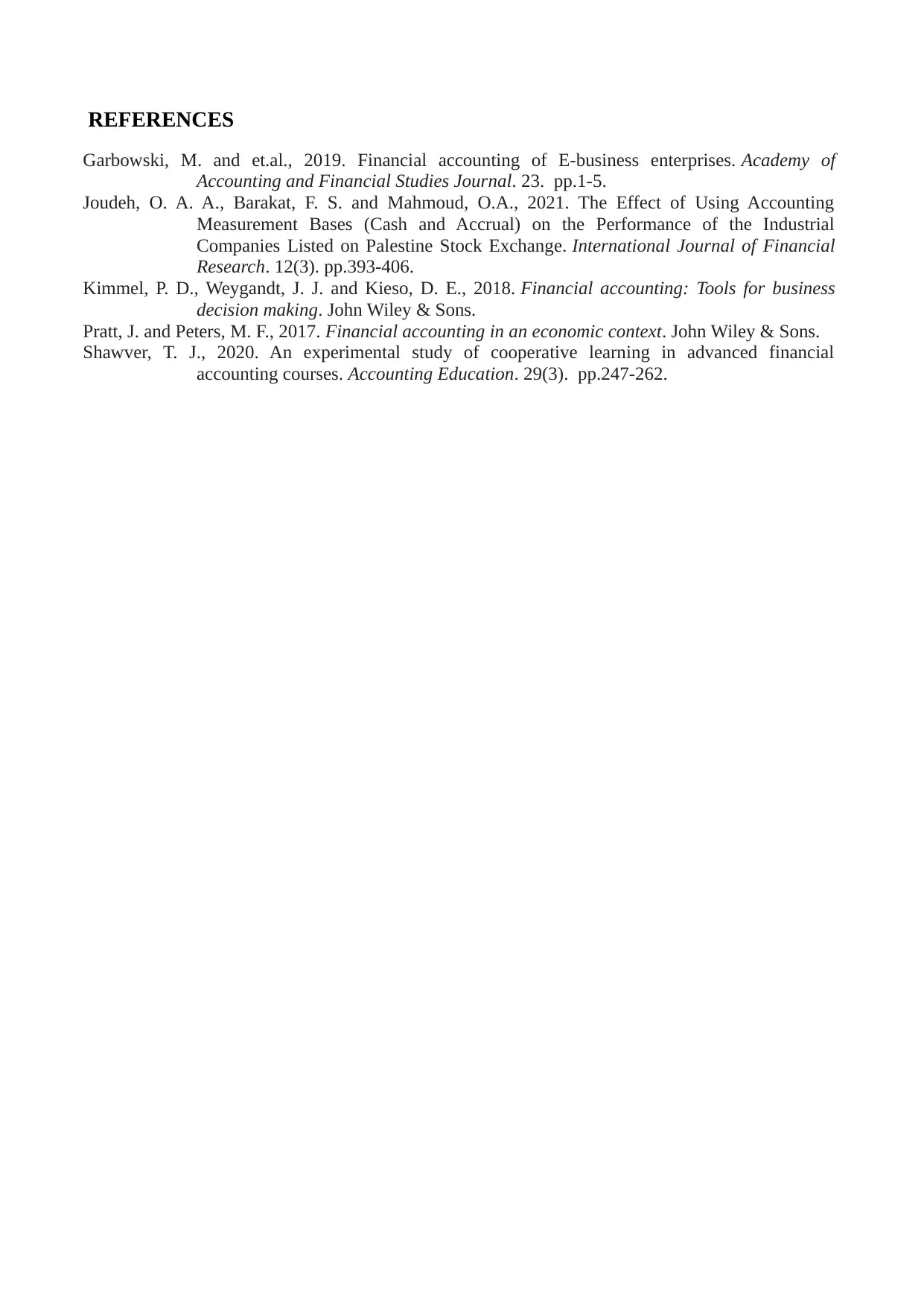
REFERENCES
Garbowski, M. and et.al., 2019. Financial accounting of E-business enterprises. Academy of
Accounting and Financial Studies Journal. 23. pp.1-5.
Joudeh, O. A. A., Barakat, F. S. and Mahmoud, O.A., 2021. The Effect of Using Accounting
Measurement Bases (Cash and Accrual) on the Performance of the Industrial
Companies Listed on Palestine Stock Exchange. International Journal of Financial
Research. 12(3). pp.393-406.
Kimmel, P. D., Weygandt, J. J. and Kieso, D. E., 2018. Financial accounting: Tools for business
decision making. John Wiley & Sons.
Pratt, J. and Peters, M. F., 2017. Financial accounting in an economic context. John Wiley & Sons.
Shawver, T. J., 2020. An experimental study of cooperative learning in advanced financial
accounting courses. Accounting Education. 29(3). pp.247-262.
Garbowski, M. and et.al., 2019. Financial accounting of E-business enterprises. Academy of
Accounting and Financial Studies Journal. 23. pp.1-5.
Joudeh, O. A. A., Barakat, F. S. and Mahmoud, O.A., 2021. The Effect of Using Accounting
Measurement Bases (Cash and Accrual) on the Performance of the Industrial
Companies Listed on Palestine Stock Exchange. International Journal of Financial
Research. 12(3). pp.393-406.
Kimmel, P. D., Weygandt, J. J. and Kieso, D. E., 2018. Financial accounting: Tools for business
decision making. John Wiley & Sons.
Pratt, J. and Peters, M. F., 2017. Financial accounting in an economic context. John Wiley & Sons.
Shawver, T. J., 2020. An experimental study of cooperative learning in advanced financial
accounting courses. Accounting Education. 29(3). pp.247-262.
⊘ This is a preview!⊘
Do you want full access?
Subscribe today to unlock all pages.

Trusted by 1+ million students worldwide
1 out of 9
Related Documents
Your All-in-One AI-Powered Toolkit for Academic Success.
+13062052269
info@desklib.com
Available 24*7 on WhatsApp / Email
![[object Object]](/_next/static/media/star-bottom.7253800d.svg)
Unlock your academic potential
Copyright © 2020–2025 A2Z Services. All Rights Reserved. Developed and managed by ZUCOL.



